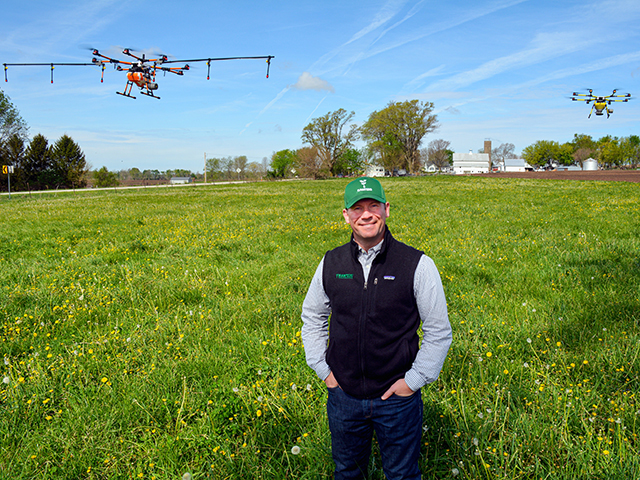Autonomous Ag Drones Work Together
Iowa Company Develops Multiple Autonomous Drone Systems to Spray or Seed Fields
A heavy downpour would be a disaster for most field days. But, the muddy mess was the perfect opportunity for Michael Ott, CEO of Rantizo, to show off how a new system of unmanned aerial vehicles (UAVs) works together to spray pesticides and seed crops.
"If you needed to spray today, you couldn't with a ground rig," Ott says during a media day at the company proving grounds near Iowa City, Iowa. "But, our drone systems can do it. People are realizing a drone can treat areas that tractors or self-propelled sprayers are not suitable for."
Rantizo, which means "to sprinkle" in Greek, has spread its wings recently by developing technology and equipment so multiple UAVs can work together to spray or seed fields efficiently. In this case, up to three drones called "a swarm" can apply herbicides, fungicides, insecticides, nutrients and cover-crop seeds.
Visit https://www.dtnpf.com/… to read a 2019 DTN/Progressive Farmer story on the tech startup company.
Rantizo started in 2018 modifying DJI Agras drones with a proprietary Spray Upgrade Kit, which includes a configurable 14-foot boom and enhancement to pumps that increase spray productivity and coverage. Drones can also be equipped to broadcast cover-crop seed.
One drone can cover up to 14 acres per hour. Now, Rantizo has developed a system that allows a licensed drone pilot and a visual observer to fly up to three drones autonomously and simultaneously to cover more acres.
Earlier this year, the company added a Load N Go trailer to outfit ag retailers and custom applicators with everything needed for drone applications. It includes a swarm of three drones, batteries, custom storage space, generator, water and chemical tanks, autonomous chemical mixing equipment and more. The cost for the trailer and everything in it is about $145,000, which can vary based on options selected.
Ott doesn't see drones replacing self-propelled or pull-type sprayers or airplanes as the primary application method of chemicals and fertilizer. He also expects planters and drills to seed the bulk of cover crops. However, Ott sees UAVs as valuable tools because they can:
P[L1] D[0x0] M[300x250] OOP[F] ADUNIT[] T[]
-- Make spot applications.
-- Treat or seed fields promptly that are too wet to support heavy equipment when soil compaction is a concern.
-- Spray and seed fields with obstacles or in or near urban areas that make traditional applications difficult.
"Rantizo's system complements ground rigs and crop dusters," Ott explains. "Farmers and applicators have invested in that equipment to solve 100% of their problems, but it's really only good for 75 to 80% of their needs.
"Maybe you have a portion of a field to spray for weeds. We can do it without spraying the entire thing or having a negative effect on the crop (possibly running over plants)," he continues. "Site-specific spraying (with our drones) can be done more efficiently than anything else on the market."
Ultimately, drones can save time and money when it comes to spot-spraying and seeding, Ott claims. And, potentially, boost productivity and profit potential.
Ag Partners Cooperative, based in Seneca, Kansas, was one of the first businesses to purchase a drone system from Rantizo as an application services contractor.
The cooperative sells seed, chemicals, fertilizer and custom sprays.
The co-op used Rantizo's drone system to apply fungicides and insecticides on about 400 acres of alfalfa, hard winter wheat and cereal rye in May. Many of those acres were either too wet to use a ground rig, or it was easier to use a drone because of terraces, says Ethan Noll, Ag Partners head of digital ag.
"This (drone use) is right in our wheelhouse," Noll says. "We're trying to use technology to push farmers to the next level of micromanagement down to the acre or even the square foot."
Rantizo has a growing network of about 40 contractors, such as Ag Partners, available to provide custom drone application services to growers. The company has federal permits to fly drone swarms in 48 states and is licensed in 19 states as of late May.
**
For More Information:
-- Please read a previous DTN story about Rantizo: https://www.dtnpf.com/…
-- Rantizo: www.rantizo.com
Follow Matthew Wilde on Twitter @progressivwilde
(c) Copyright 2021 DTN, LLC. All rights reserved.



